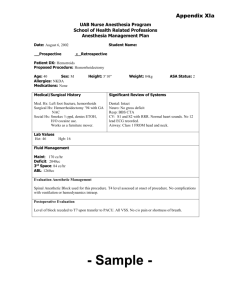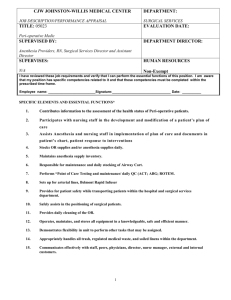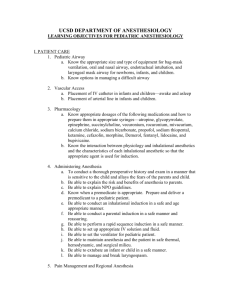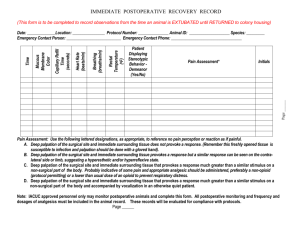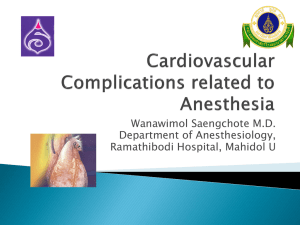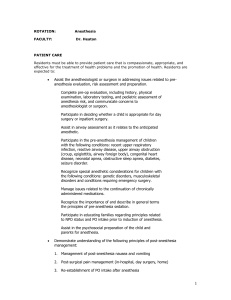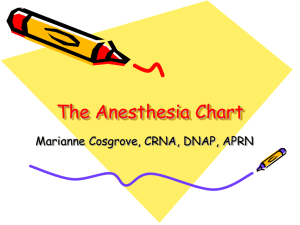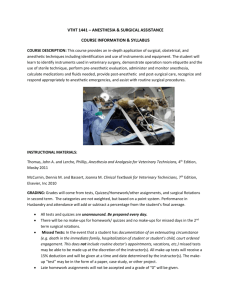ii. goals and objectives
advertisement
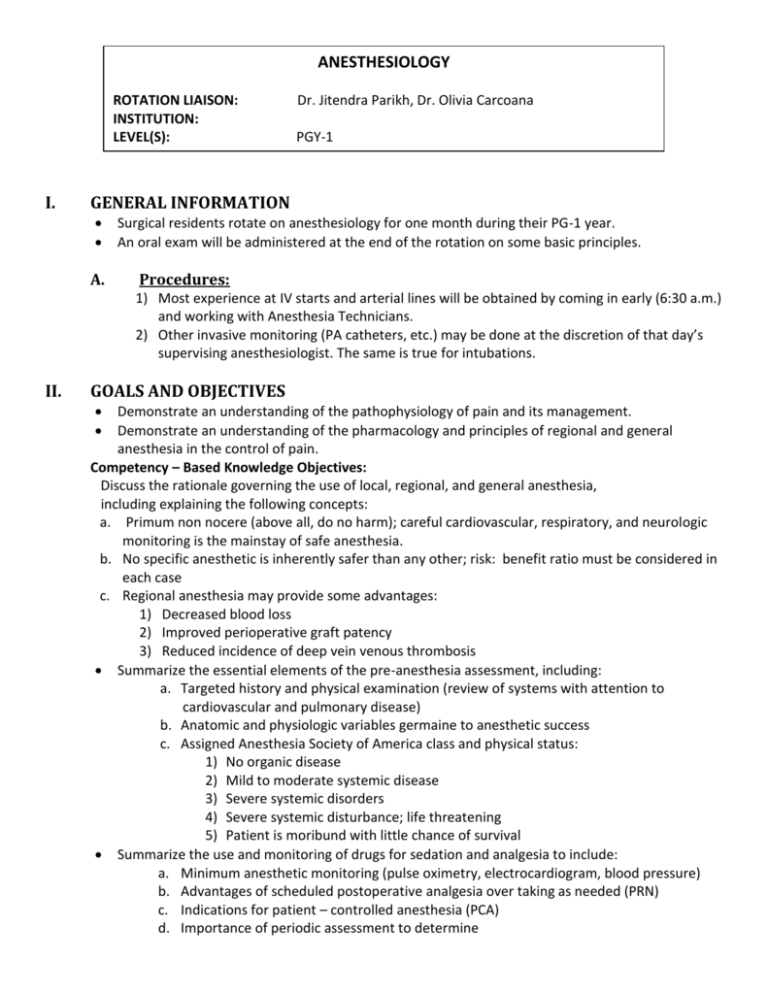
ANESTHESIOLOGY ROTATION LIAISON: INSTITUTION: LEVEL(S): I. Dr. Jitendra Parikh, Dr. Olivia Carcoana PGY-1 GENERAL INFORMATION A. Surgical residents rotate on anesthesiology for one month during their PG-1 year. An oral exam will be administered at the end of the rotation on some basic principles. Procedures: 1) Most experience at IV starts and arterial lines will be obtained by coming in early (6:30 a.m.) and working with Anesthesia Technicians. 2) Other invasive monitoring (PA catheters, etc.) may be done at the discretion of that day’s supervising anesthesiologist. The same is true for intubations. II. GOALS AND OBJECTIVES Demonstrate an understanding of the pathophysiology of pain and its management. Demonstrate an understanding of the pharmacology and principles of regional and general anesthesia in the control of pain. Competency – Based Knowledge Objectives: Discuss the rationale governing the use of local, regional, and general anesthesia, including explaining the following concepts: a. Primum non nocere (above all, do no harm); careful cardiovascular, respiratory, and neurologic monitoring is the mainstay of safe anesthesia. b. No specific anesthetic is inherently safer than any other; risk: benefit ratio must be considered in each case c. Regional anesthesia may provide some advantages: 1) Decreased blood loss 2) Improved perioperative graft patency 3) Reduced incidence of deep vein venous thrombosis Summarize the essential elements of the pre-anesthesia assessment, including: a. Targeted history and physical examination (review of systems with attention to cardiovascular and pulmonary disease) b. Anatomic and physiologic variables germaine to anesthetic success c. Assigned Anesthesia Society of America class and physical status: 1) No organic disease 2) Mild to moderate systemic disease 3) Severe systemic disorders 4) Severe systemic disturbance; life threatening 5) Patient is moribund with little chance of survival Summarize the use and monitoring of drugs for sedation and analgesia to include: a. Minimum anesthetic monitoring (pulse oximetry, electrocardiogram, blood pressure) b. Advantages of scheduled postoperative analgesia over taking as needed (PRN) c. Indications for patient – controlled anesthesia (PCA) d. Importance of periodic assessment to determine 1) Level of consciousness 2) Pulmonary status in sedated patients Summarize the principles of administration for and compare the effectiveness of the following methods of anesthesia: a. General b. Spinal c. Regional d. Local Describe the potential benefits of regional and local anesthesia to include: a. Decreased respiratory depression b. Diminished systemic effects (liver and renal toxicity) c. Decreased direct cardiac depression Outline the potential complications associated with the use of regional anesthesia, including: a. Spinal anesthetics (headache, cerebrospinal fluid (CSF) leak, meningitis) b. Regional nerve blocks (perineural hematomas) Analyze anesthetic monitoring techniques to include: a. Swan – Ganz catheters b. Arterial lines c. Transvenous pacemakers Describe the techniques and potential complications of managing an airway, including endotracheal and nasotracheal intubation. Describe and explain the most common immediate postoperative anesthetic issues: a. Airway stability b. Ventilation and oxygenation c. Pain control d. Nausea and vomiting e. Temperature regulation f. Hemodynamic stability Competency – Based Performance Objectives: Manage the airway in adults and children, employing appropriate: a. Physical maneuvers b. Oral/nasal support devices c. Suctioning techniques to maintain clear airway Perform nasal and oral intubation. Recognize and treat the signs and symptoms of complications due to anesthetic agents such as: a. Cardiovascular collapse b. Acute metabolic disturbances c. Malignant hyperthermia Perform preoperative assessment of patients. Recognize risks and possible side effects of drugs used for pain control. Write orders for preparation of patients for administration of anesthesia. ACGME Core Competencies 1. Patient Care that is compassionate, appropriate, and effective for the treatment of health programs and the promotion of health. Surgical residents must: a. Demonstrate manual dexterity appropriate for their training level. Central line insertion, intubation, etc. b. Be able to develop and execute patient care plans appropriate for the resident’s level. Assess peri-operative risks; assign appropriate ASA classification 2. Medical Knowledge about established and evolving biomedical, clinical, and cognate (e.g., epidemiological and social-behavioral) sciences, as well as the application of knowledge to patient care. Surgical residents are expected to critically evaluate and demonstrate knowledge of pertinent scientific information. See competency based objectives above. 3. Practice-based learning and improvement that involves the investigation and evaluation of care for their patients, the appraisal and assimilation of scientific evidence, and improvements in patient care. Surgical residents are expected to: a. Critique personal practice outcomes. Examples: perioperative complications such as MI, respiratory distress, CHF b. Demonstrate a recognition of the importance of lifelong learning in surgical practice. Examples: Adequate knowledge acquisition for each day’s cases/conditions. 4. Interpersonal and communication skills that result in the effective exchange of information and collaboration with patients, their families, and other health professionals. Surgical residents are expected to: a. Communicate effectively with other health care professionals. Examples: discussion of intra operative developments which may affect post operative management b. Counsel and educate patients and families. Examples: informed consent concerning anesthesia risks and methods. c. Effectively document practice activities. Examples: procedural notes, estimates developments/problems. 5. Professionalism, as manifested through a commitment to carrying out professional responsibilities, adherence to ethical principles, and sensitivity to patients of diverse backgrounds. Surgical residents are expected to: a. Maintain high standards of ethical behavior. Examples: protection of privileged information, patient before self. b. Demonstrate a commitment to continuity of patient care. Example: pre-operative assessment, post-operative visits. c.Demonstrate sensitivity to age, gender and culture of patients and other health care professionals. Example: appreciate barriers secondary to language/learning disorders/dementia. 6. Systems-bases practice, as manifested by actions that demonstrate an awareness of and responsiveness to the large context and system of health care, as well as the ability to call effectively on other resources in the system to provide optimal health care. Surgical residents are expected to: a. Practice high quality, cost effective patient care. Examples: post-operative analgesia significantly impacts comfort as well as outcomes, choice and timing of peri-operative antibiotic prophylaxis. b. Demonstrate a knowledge of risk-benefit analysis. Examples: depending upon age and pre-existing medical conditions the best choice could be comfort care not an invasive procedure c. Demonstrate an understanding of the role of different specialists and other health care professionals in overall patient management. Examples: anesthesia plays a vital role in the management of the surgical patient but is only one part of the continuum of care which includes nursing, clergy, social work, the surgical team, and innumerable other healthcare professionals which all participate. III. EXPECTATIONS – See above IV. TEACHING METHODS – supervised/observed patient encounters. V. DUTY HOURS VI. The workday begins at 6:30 a.m. You are dismissed by the anesthesiologist with whom you are working that day (usually 3-4 p.m.). Residents may go to required didactic conferences and will then return. PROCEDURAL OPPORTUNITIES – Available on a daily basis. VII. EVALUATION A computerized evaluation will be completed by the faculty at the end of each rotation. Additionally, you are required to submit your evaluation of the rotation and faculty to the residency director. VIII. READING LIST IX. CONTACTS Dr. Jitendra Parikh; Dr. Olivia Carcoana Anesthesia Department Altru Hospital 1000 So Columbia Rd Grand Forks, ND 58201 5/25/10
